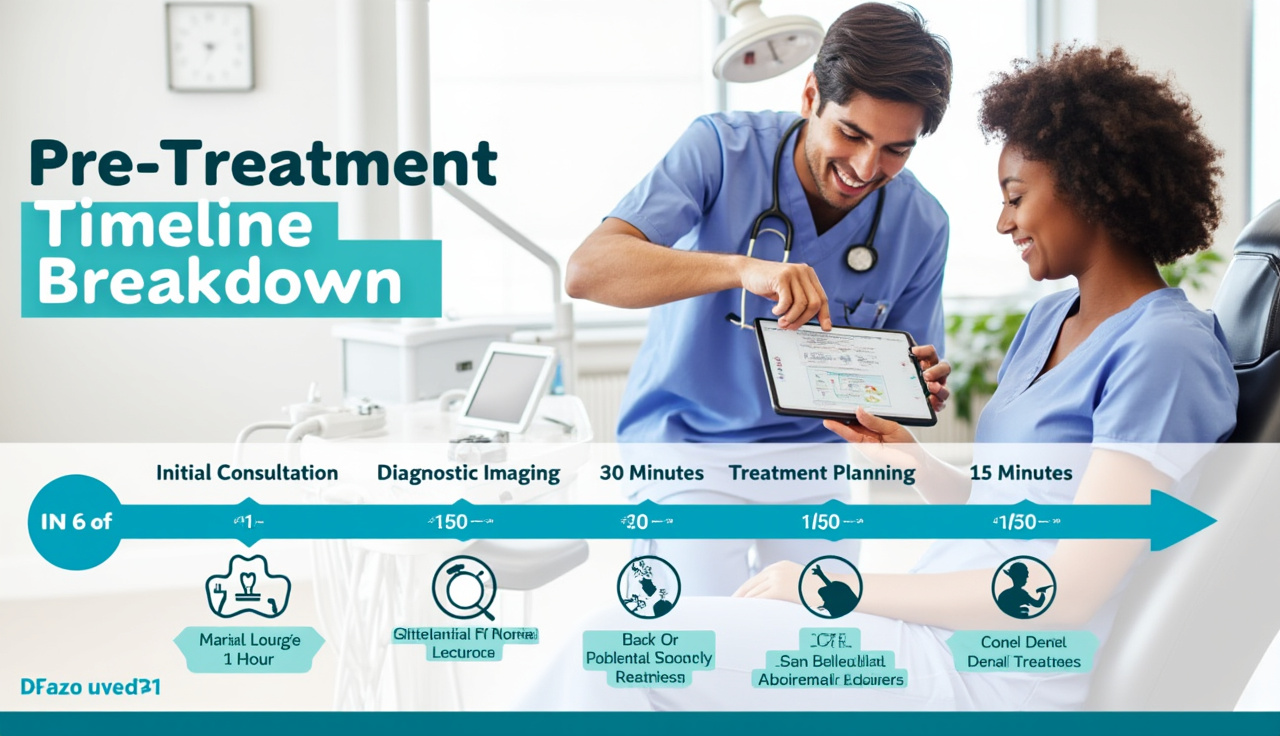A root canal treatment typically takes 30-90 minutes per session, with most people needing 1-2 visits to finish the whole thing. Your exact treatment time depends on which tooth needs work and how bad the problem is.
Here’s the thing: Getting a root canal isn’t a one-size-fits-all deal.
Think about it – fixing a front tooth with one straight root is like taking the highway to your destination. But working on a molar with three curved roots? That’s more like navigating through busy city streets during rush hour. Your dentist might need extra time to clean and seal those tricky spots properly.
Want to know exactly how long your root canal might take? I’ve dug through real dental data and patient stories to map out every step of the process. From the moment you sit in the dental chair to when you can grab lunch with friends again, I’ll walk you through the whole timeline – no dental jargon, just straight talk.
Understanding Root Canal Duration Factors

Want to know exactly how long a root canal takes? Here’s the deal:
A typical root canal treatment takes between 30 to 90 minutes. But your actual time in the dentist’s chair depends on which tooth needs fixing.
Here’s what affects your treatment time:
Tooth Location Impact on Treatment Time
Front teeth are quick – usually 30-60 minutes. They’re straight and have one root, making them easier to treat.
But molars? They’re trickier. These back teeth often need 60-90 minutes because they have 2-3 roots. Think of it like untangling headphone cords – more wires means more time!
Real data from dental practices shows:
– Front teeth: 30-60 minutes
– Premolars: 45-75 minutes
– Molars: 60-90 minutes
Complexity Levels and Their Time Requirements
The more complicated your case, the longer it takes. Here’s what makes a root canal take extra time:
- Severe infections need more cleaning time
- Curved root canals are harder to clean
- Multiple root canals in one tooth take longer
- Tooth anatomy that’s unusual needs special care
If your dentist spots any of these during your x-rays, they might need an extra visit to finish the job. Most root canals wrap up in 1-2 visits, with each visit lasting about an hour.
Think your tooth might need a root canal? The sooner you see a dentist, the simpler (and faster) your treatment will be!
Pre-Treatment Timeline Breakdown

Getting ready for a root canal but not sure how long you’ll need to set aside? I get it – nobody likes surprises when it comes to dental procedures.
Here’s the deal: The pre-treatment phase usually takes 1-2 weeks from your first toothache to actually getting the procedure done.
Let’s break down exactly what happens before your root canal treatment starts:
Diagnostic Phase Duration
Your first stop is the initial consultation, which takes about 30-45 minutes. During this visit, your dentist will:
– Check your tooth sensitivity
– Take dental x-rays (15 minutes)
– Review your medical history
– Plan your treatment
The time between your consultation and actual procedure depends on two things:
- Emergency cases: If you’re in severe pain or have a bad infection, you might get treatment the same day
- Planned procedures: For non-emergency cases, expect to wait 3-7 days
Testing Requirements
Before getting the green light, you’ll need:
– Digital x-rays (must be recent – within 6 months)
– Oral examination to check tooth structure
– Pain threshold assessment
– Infection check
Think your case might be urgent? These signs mean you need emergency dental care:
– Severe toothache
– Facial swelling
– Fever
– Chronic pain that keeps you up at night
Remember: Getting your pre-treatment steps done right means a smoother root canal therapy later. Your dentist isn’t being slow – they’re being thorough!
The Main Procedure: Step-by-Step Duration

Want to know exactly how long your root canal will take? Here’s the real deal:
A root canal typically takes 60-90 minutes for a single tooth. But that’s just the treatment part – your total time in the dentist’s chair might be different.
Here’s why the timing can change:
– Which tooth needs fixing (back teeth take longer)
– How bad the infection is
– If you need extra X-rays
– Your dentist’s experience level
Preparation and Anesthesia Phase (15-30 minutes)
First up is getting you comfortable. Your dentist will:
– Take X-rays (5-10 minutes)
– Give you local anesthesia (5-10 minutes)
– Wait for numbness to kick in (5-10 minutes)
Think it’s not enough time for the numbness? Don’t worry – your dentist won’t start until you’re completely numb.
Core Treatment Duration (45-60 minutes)
This is where the magic happens. Your dentist will:
– Clean out the bad stuff (20-25 minutes)
– Shape the root canals (15-20 minutes)
– Fill and seal the tooth (10-15 minutes)
Got a tricky case? Things that might make it take longer:
– Curved or narrow root canals
– Multiple roots (like in back teeth)
– Extra infection to clean out
– Your comfort breaks
Remember: rushing a root canal is like rushing a good meal – it’s better to take the right amount of time and do it right!
Multiple Visit Scenarios

Sometimes your root canal treatment needs more than one visit to get the job done right. Here’s the deal: while many root canals can be completed in a single appointment, complex cases often need extra time.
When Additional Appointments Are Necessary
Your dentist might split your treatment into multiple visits if:
– Your tooth infection is severe
– You have curved or narrow root canals
– There are multiple roots to treat
– You need extra time for the infection to clear up
– Your tooth needs a permanent crown
The time between visits usually ranges from 1-2 weeks. This waiting period helps your tooth heal and lets your dentist make sure the infection is gone before sealing everything up.
Success Rates and Treatment Outcomes
Let’s talk numbers: root canals done over multiple visits are just as successful as single-visit treatments. Research shows both approaches have success rates above 90%.
But here’s something cool: spreading out your treatment can actually be better if you have:
– A really painful tooth
– Swelling in your gums
– Complex root structure
– A history of dental problems
Your dentist will pick the best approach for your specific case. Think of it like building a house – sometimes you need extra time to make sure everything’s perfect!
Remember: while multiple visits might take longer, they give your tooth the best chance for long-term health. Plus, you’ll get the same great results as a single visit – just with extra care and attention.
Recovery Timeline Expectations

Wondering how long it’ll take to feel normal after your root canal? Let me break it down for you.
Here’s the deal: Most people can get back to their daily routine the very same day after a root canal treatment.
Immediate Post-Procedure Period
The first 24 hours are super important. Right after your root canal, your mouth will feel numb for 2-4 hours from the local anesthesia. This is totally normal!
Your hour-by-hour recovery might look like this:
– First 2-4 hours: Mouth feels numb
– 4-8 hours: Numbness wears off, mild discomfort begins
– 8-24 hours: Some tooth sensitivity when eating
Watch out for these normal signs:
– Mild pain when biting
– Tender gums
– Slight jaw soreness
But call your dentist if you notice:
– Severe pain that gets worse
– Major swelling
– Bite feels way off
– Infection symptoms (fever, pus)
Long-Term Healing Process
Your tooth keeps getting better week by week:
Week 1:
– Mild sensitivity goes away
– Can eat normal foods (just be gentle!)
– Pain should be gone
Weeks 2-4:
– Tooth feels stronger
– Dentist places permanent crown (if needed)
– Back to 100% normal biting
Complete healing:
– Takes about 1-2 months
– Success rate is super high (95%)
– Tooth can last a lifetime with good care
Remember: Most people get their permanent crown 2-3 weeks after the root canal. This protects your tooth and lets you eat normally again.
Treatment Scheduling Considerations

Planning your root canal treatment isn’t as tricky as you might think. Most dental clinics offer flexible scheduling options to fit your needs.
Here’s the thing: The best time to schedule your root canal depends on your situation.
Optimal Timing for Root Canal Treatment
The ideal time for a root canal is early morning or right after lunch. Why? You’ll be fresh and relaxed, and the dentist’s office will typically be less busy.
Morning appointments work great because:
– Your pain tolerance is highest
– You’re less tired
– Dental staff are most energized
– Shorter waiting times
But if you’re dealing with a toothache right now, don’t wait! Emergency dental care is available 24/7 at most clinics.
Emergency vs. Planned Procedures
Got sudden tooth pain? That’s different from a planned root canal therapy:
Emergency Root Canals:
– Same-day appointments
– Focus on quick pain relief
– May need follow-up visits
– Often done in 1-2 hours
Planned Root Canals:
– More scheduling options
– Complete treatment in one visit
– Better insurance coordination
– Less rushed experience
Smart tip: Book your root canal on a Thursday or Friday. This gives you the weekend to rest and avoid using sick days at work.
Remember: Your dentist can work with your schedule. Just let them know about your work hours or family commitments, and they’ll help find the perfect time slot for your treatment.
Your Next Steps: Making Your Root Canal Experience Smooth and Simple

Look:
Getting a root canal isn’t something anyone looks forward to. But knowing what to expect makes it so much easier to handle. And now you know exactly what’s ahead – from the 30-90 minute procedure time to your full recovery path.
Here’s the thing:
At Inspire Dental, we understand that dental procedures can feel overwhelming, especially for families juggling busy schedules. That’s why our faith-based practice in Ottumwa makes the process as comfortable and straightforward as possible.
Want to take the first step?
Fill out our quick contact form right now, and our caring team will help schedule your appointment at a time that works best for you and your family. We’ll walk you through each step, answer your questions, and make sure you feel completely confident about your treatment plan.
Ready to get started? Click the “Contact Us” button below or call our office. Let’s work together to keep your smile healthy and bright!
